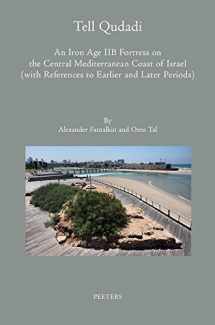
Tell Qudadi: An Iron Age Iib Fortress on the Central Mediterranean Coast of Israel (with References to Earlier and Later Periods): Final Report on the ... Participation of N. Aviga (Colloquia Antiqua)
ISBN-13:
9789042931824
ISBN-10:
9042931825
Author:
A Fantalkin, O Tal
Publication date:
2015
Publisher:
Peeters
Format:
Hardcover
262 pages
FREE US shipping
Book details
ISBN-13:
9789042931824
ISBN-10:
9042931825
Author:
A Fantalkin, O Tal
Publication date:
2015
Publisher:
Peeters
Format:
Hardcover
262 pages
Summary
Tell Qudadi: An Iron Age Iib Fortress on the Central Mediterranean Coast of Israel (with References to Earlier and Later Periods): Final Report on the ... Participation of N. Aviga (Colloquia Antiqua) (ISBN-13: 9789042931824 and ISBN-10: 9042931825), written by authors
A Fantalkin, O Tal, was published by Peeters in 2015.
With an overall rating of 3.7 stars, it's a notable title among other
books. You can easily purchase or rent Tell Qudadi: An Iron Age Iib Fortress on the Central Mediterranean Coast of Israel (with References to Earlier and Later Periods): Final Report on the ... Participation of N. Aviga (Colloquia Antiqua) (Hardcover) from BooksRun,
along with many other new and used
books
and textbooks.
And, if you're looking to sell your copy, our current buyback offer is $0.52.
Description
This monograph presents the final excavation report of the Iron Age fortress at Tell Qudadi (Tell esh-Shuna) situated on the northern bank of the Yarkon river estuary in the central coast of Israel. The main excavations were conducted in 1937-38 and were published in a very preliminary form, dating the first phase of the fortress to the 10th or 9th century BC, whereas the second phase, attributed by the excavators to the northern Israelite kingdom, was ascribed to the latter part of the 9th century BC until 732 BC, when it was destroyed during the military campaign led by Tiglath-pileser III. Such a reconstruction of events was unreservedly accepted by other scholars. The present authors offer a new chronological scheme for two architectural phases of this impressive Iron Age fortress, suggesting a new chronological affiliation of the fortress to the period between the second half of the 8th and first half of the 7th centuries BC. Accordingly, the site formed part of the sophisticated network that was created on behalf of the Neo-Assyrian rule. The study of the site's Iron Age IIB pottery assemblages enables a reassessment of a number of contested chronological issues in a wider Mediterranean setting.


We would LOVE it if you could help us and other readers by reviewing the book
Book review

Congratulations! We have received your book review.
{user}
{createdAt}
by {truncated_author}


